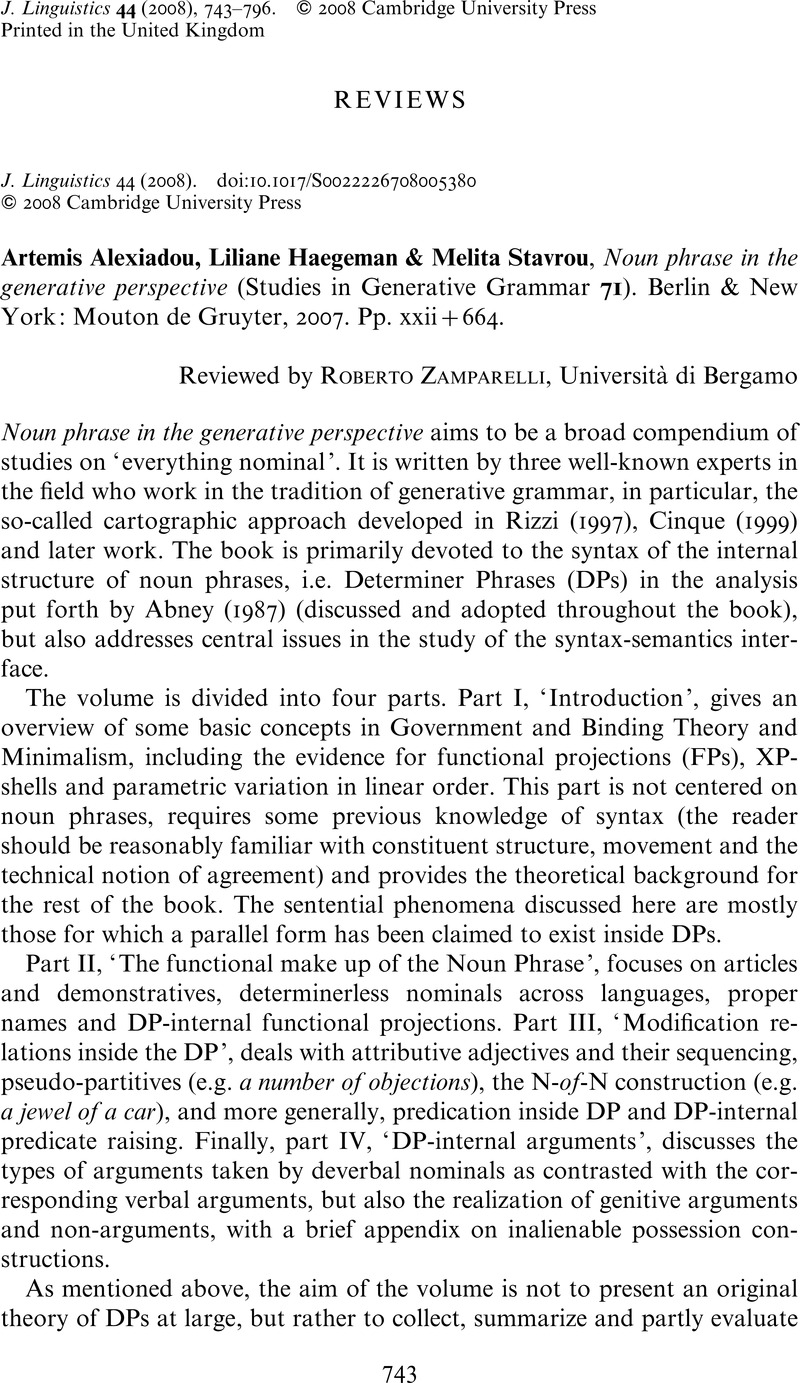No CrossRef data available.
Article contents
Artemis Alexiadou, Liliane Haegeman & Melita Stavrou, Noun phrase in the generative perspective (Studies in Generative Grammar 71). Berlin & New York: Mouton de Gruyter, 2007. Pp. xxii+664.
Published online by Cambridge University Press: 16 October 2008
Abstract
An abstract is not available for this content so a preview has been provided. Please use the Get access link above for information on how to access this content.

- Type
- Reviews
- Information
- Copyright
- Copyright © 2008 Cambridge University Press
References
REFERENCES
Abels, Klaus & Neeleman, Ad. 2006. Universal 20 without the LCA (version 1). Ms., University of Tromsø & University College London. http://ling.auf.net/lingbuzz/@NEZNvgQDnYgsHuYL/nroHLtvl?3 (15 July 2008).Google Scholar
Abney, Steven. 1987. The English noun phrase in its sentential aspect. Ph.D. dissertation, MIT.Google Scholar
Aboh, Enoch. 1998. From the syntax of Gungbe to the grammar of Gbe. Ph.D. dissertation, University of Geneva.Google Scholar
Alexiadou, Artemis. 2001. Functional structure in nominals: Nominalization and ergativity (Linguistics Today 42). Amsterdam & Philadelphia: John Benjamins.CrossRefGoogle Scholar
Alexiadou, Artemis & Wilder, Chris (eds.). 1998. Possessors, predicates and movement in the Determiner Phrase (Linguistics Today 22). Amsterdam & Philadelphia: John Benjamins.CrossRefGoogle Scholar
Barwise, Jon & Cooper, Robin. 1981. Generalized quantifiers and natural language. Linguistics and Philosophy 4.2, 159–219.CrossRefGoogle Scholar
Bernstein, Judy B. 1993. Topics in the syntax of nominal structure across Romance. Ph.D. dissertation, City University of New York.Google Scholar
Bouchard, Denis. 2002. Adjectives, number and interfaces: Why languages vary (North-Holland Linguistic Series 61). Amsterdam: Elsevier.CrossRefGoogle Scholar
Carlson, Gregory N. 1977. Reference to kinds in English. Ph.D. dissertation, University of Massachusetts, Amherst.Google Scholar
Cheng, Lisa Lai-Shen & Sybesma, Rint. 1999. Bare and not-so-bare nouns and the structure of NP. Linguistic Inquiry 30.4, 509–542.CrossRefGoogle Scholar
Chierchia, Gennaro. 1998. Reference to kinds across languages. Natural Language Semantics 6, 339–405.CrossRefGoogle Scholar
Cinque, Guglielmo. 1994. On the evidence for partial N-movement in the Romance DP. In Cinque, Guglielmo, Koster, Jan, Pollock, Jean-Yves, Rizzi, Luigi & Zanuttini, Raffaella (eds.), Paths towards Universal Grammar: Studies in honor of Richard S. Kayne (Georgetown Studies in Romance Linguistics), 85–110. Washington, DC: Georgetown University Press.Google Scholar
Cinque, Guglielmo. 1999. Adverbs and functional heads: A cross-linguistic perspective (Oxford Studies in Comparative Syntax). New York & Oxford: Oxford University Press.CrossRefGoogle Scholar
Corver, Norbert. 1998. Predicative movement in pseudopartitive constructions. In Alexiadou, & Wilder, (eds.), 215–258.Google Scholar
Diesing, Molly. 1992. Indefinites (Linguistic Inquiry Monographs 20). Cambridge, MA: MIT Press.Google Scholar
Dikken, Marcel den. 1995. Particles: On the syntax of verb particle, triadic, and causative constructions. New York & Oxford: Oxford University Press.CrossRefGoogle Scholar
Dikken, Marcel den. 1998. Predicate inversion in DP. In Alexiadou, & Wilder, (eds.), 177–214.Google Scholar
Fukui, Naoki. 1986. A theory of category projection and its application. Ph.D. dissertation, MIT.Google Scholar
Giusti, Giuliana. 1992. Heads and modifiers among determiners: Evidence from Romanian and German. University of Venice Working Papers in Linguistics 2, 1–19.Google Scholar
Giusti, Giuliana. 2002. The functional structure of noun phrases: A bare phrase structure approach. In Cinque, Guglielmo (ed.), Functional structure in DP and IP: The cartography of syntactic structures, vol. 1 (Oxford Studies in Comparative Syntax), 54–90. Oxford: Oxford University Press.CrossRefGoogle Scholar
Grimshaw, Jane B. 1990. Argument structure (Linguistic Inquiry Monographs 18). Cambridge, MA: MIT Press.Google Scholar
Heim, Irene. 1982. The semantics of definite and indefinite noun phrases. Ph.D. dissertation, University of Massachusetts, Amherst.Google Scholar
Heycock, Caroline & Zamparelli, Roberto. 2005. Friends and colleagues: Plurality, coordination, and the structure of DP. Natural Language Semantics 13, 201–270.CrossRefGoogle Scholar
Hoeksema, Jacob (ed.). 1996. Partitives: Studies on the syntax and semantics of partitive and related constructions (Groningen–Amsterdam Studies in Semantics 14). Berlin: Mouton de Gruyter.Google Scholar
Kayne, Richard S. 1994. The antisymmetry of syntax (Linguistic Inquiry Monographs 25). Cambridge, MA: MIT Press.Google Scholar
King, Jeffrey C. 2001. Complex demonstratives: A quantificational account (Contemporary Philosophical Monographs 2). Cambridge, MA: MIT Press.CrossRefGoogle Scholar
Link, Godehard. 1983. The logical analysis of plurals and mass terms: A lattice-theoretical approach. In Bäuerle, Rainer, Schwarze, Christoph & Stechow, Arnim von (eds.), Meaning, use, and interpretation of language (Foundation of Communication), 302–323. Berlin: Walter de Gruyter.CrossRefGoogle Scholar
Longobardi, Giuseppe. 1994. Reference and proper names: A theory of N-movement in syntax and logical form. Linguistic Inquiry 25.4, 609–665.Google Scholar
Longobardi, Giuseppe. 2002. How comparative is semantics? A unified parametric theory of bare nouns and proper names. Natural Language Semantics 9, 335–369.CrossRefGoogle Scholar
Lyons, Christopher. 1999. Definiteness (Cambridge Textbooks in Linguistics). Cambridge: Cambridge University Press.CrossRefGoogle Scholar
Moro, Andrea. 1997. The raising of predicates: Predicative noun phrases and the theory of clause structure (Cambridge Studies in Linguistics 80). Cambridge: Cambridge University Press.CrossRefGoogle Scholar
Partee, Barbara H. In press. Privative adjectives: Subsective plus coercion. In Bäuerle, Rainer, Reyle, Uwe & Zimmermann, Thomas E. eds.), Presuppositions and discourse: Essays offered to Hans Kamp. Amsterdam: Elsevier. http://people.umass.edu/partee/docs/ParteeInPressKampFest.pdf (15 July 2008).Google Scholar
Prince, Ellen F. 1988. The ZPG letter: Subjects, definiteness, and information-status. In Mann, William C. & Thompson, Sandra A. eds.), Discourse description: Diverse analyses of a fund-raising text (Pragmatics & Beyond, New Series 16), 295–325. Amsterdam & Philadelphia: John Benjamins.Google Scholar
Rizzi, Luigi. 1997. The fine structure of the left periphery. In Haegeman, Liliane (ed.), Elements of grammar: Handbook in generative syntax (Kluwer International Handbooks of Linguistics 1), 281–337. Dordrecht: Kluwer.CrossRefGoogle Scholar
Zamparelli, Roberto. 1996. Layers in the Determiner Phrase. Ph.D. dissertation, University of Rochester.Google Scholar
Zamparelli, Roberto. 2005. Bare predicate nominals in Romance languages. Ms., Università di Bergamo.Google Scholar




